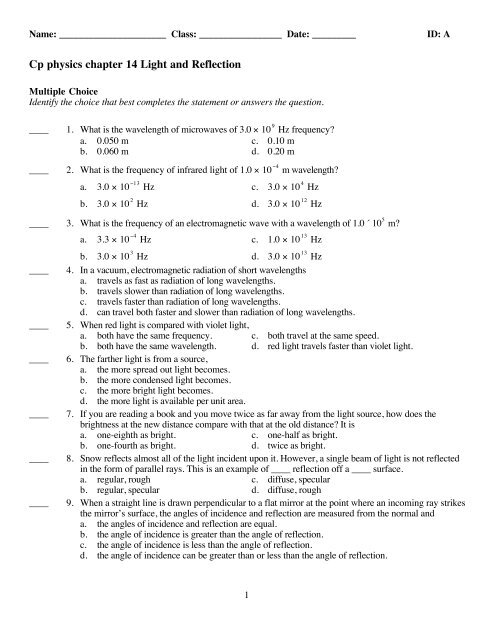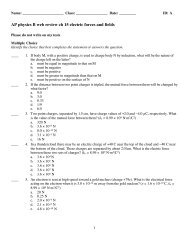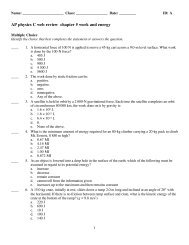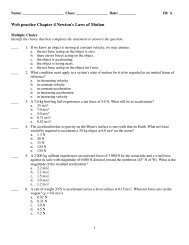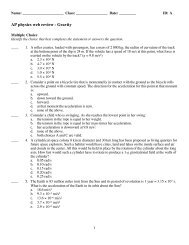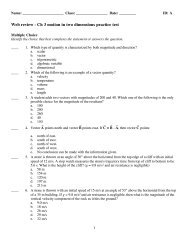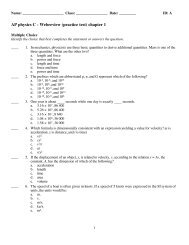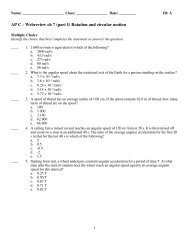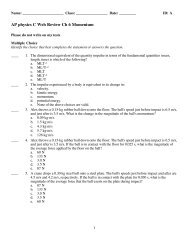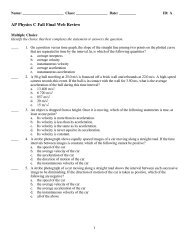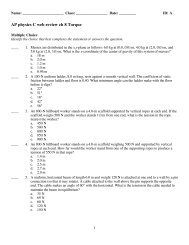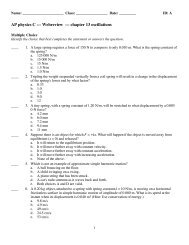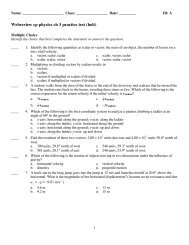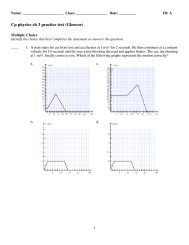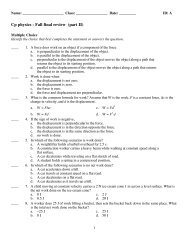Cp physics chapter 14 Light and Reflection
take home test Reflection - Planet Holloway
take home test Reflection - Planet Holloway
- No tags were found...
You also want an ePaper? Increase the reach of your titles
YUMPU automatically turns print PDFs into web optimized ePapers that Google loves.
Name: ______________________ Class: _________________ Date: _________<br />
ID: A<br />
<strong>Cp</strong> <strong>physics</strong> <strong>chapter</strong> <strong>14</strong> <strong>Light</strong> <strong>and</strong> <strong>Reflection</strong><br />
Multiple Choice<br />
Identify the choice that best completes the statement or answers the question.<br />
____<br />
____<br />
1. What is the wavelength of microwaves of 3.0 × 10 9 Hz frequency?<br />
a. 0.050 m c. 0.10 m<br />
b. 0.060 m d. 0.20 m<br />
2. What is the frequency of infrared light of 1.0 × 10 −4 m wavelength?<br />
a. 3.0 × 10 −13 Hz c. 3.0 × 10 4 Hz<br />
b. 3.0 × 10 2 Hz d. 3.0 × 10 12 Hz<br />
____ 3. What is the frequency of an electromagnetic wave with a wavelength of 1.0 ´ 10 5 m?<br />
____<br />
____<br />
____<br />
____<br />
____<br />
____<br />
a. 3.3 × 10 −4 Hz c. 1.0 × 10 13 Hz<br />
b. 3.0 × 10 3 Hz d. 3.0 × 10 13 Hz<br />
4. In a vacuum, electromagnetic radiation of short wavelengths<br />
a. travels as fast as radiation of long wavelengths.<br />
b. travels slower than radiation of long wavelengths.<br />
c. travels faster than radiation of long wavelengths.<br />
d. can travel both faster <strong>and</strong> slower than radiation of long wavelengths.<br />
5. When red light is compared with violet light,<br />
a. both have the same frequency. c. both travel at the same speed.<br />
b. both have the same wavelength. d. red light travels faster than violet light.<br />
6. The farther light is from a source,<br />
a. the more spread out light becomes.<br />
b. the more condensed light becomes.<br />
c. the more bright light becomes.<br />
d. the more light is available per unit area.<br />
7. If you are reading a book <strong>and</strong> you move twice as far away from the light source, how does the<br />
brightness at the new distance compare with that at the old distance? It is<br />
a. one-eighth as bright. c. one-half as bright.<br />
b. one-fourth as bright. d. twice as bright.<br />
8. Snow reflects almost all of the light incident upon it. However, a single beam of light is not reflected<br />
in the form of parallel rays. This is an example of ____ reflection off a ____ surface.<br />
a. regular, rough c. diffuse, specular<br />
b. regular, specular d. diffuse, rough<br />
9. When a straight line is drawn perpendicular to a flat mirror at the point where an incoming ray strikes<br />
the mirror’s surface, the angles of incidence <strong>and</strong> reflection are measured from the normal <strong>and</strong><br />
a. the angles of incidence <strong>and</strong> reflection are equal.<br />
b. the angle of incidence is greater than the angle of reflection.<br />
c. the angle of incidence is less than the angle of reflection.<br />
d. the angle of incidence can be greater than or less than the angle of reflection.<br />
1
Name: ______________________<br />
ID: A<br />
____<br />
____<br />
____<br />
____<br />
____<br />
____<br />
____<br />
____<br />
10. If a light ray strikes a flat mirror at an angle of 27° from the normal, the reflected ray will be<br />
a. 27° from the mirror’s surface. c. 90° from the mirror’s surface.<br />
b. 27° from the normal. d. 63° from the normal.<br />
11. The image of an object in a flat mirror is always<br />
a. larger than the object. c. independent of the size of the object.<br />
b. smaller than the object. d. the same size as the object.<br />
12. When two parallel mirrors are placed so that their reflective sides face each other, ____ images form.<br />
This is because the image in one mirror becomes the ____ for the other mirror.<br />
a. multiple, object c. inverted, center of curvature<br />
b. reduced, virtual image d. enlarged, focal point<br />
13. If you st<strong>and</strong> 3.0 m in front of a flat mirror, how far away from you would your image be in the<br />
mirror?<br />
a. 1.5 m c. 6.0 m<br />
b. 3.0 m d. 12.0 m<br />
<strong>14</strong>. Which of the following best describes the image produced by a flat mirror?<br />
a. virtual, inverted, <strong>and</strong> magnification greater than one<br />
b. real, inverted, <strong>and</strong> magnification less than one<br />
c. virtual, upright, <strong>and</strong> magnification equal to one<br />
d. real, upright, <strong>and</strong> magnification equal to one<br />
15. A concave mirror with a focal length of 10.0 cm creates a real image 30.0 cm away on its principal<br />
axis. How far from the mirror is the corresponding object?<br />
a. 20 cm c. 7.5 cm<br />
b. 15 cm d. 5.0 cm<br />
16. A concave mirror forms a real image at 25.0 cm from the mirror surface along the principal axis. If<br />
the corresponding object is at a 10.0 cm distance, what is the mirror’s focal length?<br />
a. 1.40 cm c. 12.0 cm<br />
b. 7.<strong>14</strong> cm d. 17.0 cm<br />
17. A convex mirror with a focal length of –20.0 cm has an object 30.0 cm in front of the mirror. What is<br />
the value of q for the corresponding image?<br />
a. −60 cm c. 12 cm<br />
b. −12 cm d. 60 cm<br />
____<br />
18. In the diagram shown above, the image of object B would be<br />
a. virtual, enlarged, <strong>and</strong> inverted. c. virtual, reduced, <strong>and</strong> upright.<br />
b. real, enlarged, <strong>and</strong> upright. d. virtual, enlarged, <strong>and</strong> upright.<br />
2
Name: ______________________<br />
ID: A<br />
____<br />
____<br />
____<br />
____<br />
____<br />
____<br />
19. In the diagram shown above, the image of object B would be<br />
a. real, reduced, <strong>and</strong> upright. c. virtual, reduced, <strong>and</strong> inverted.<br />
b. virtual, enlarged, <strong>and</strong> upright. d. virtual, reduced, <strong>and</strong> upright.<br />
20. Which best describes the image of a concave mirror when the object is located somewhere between<br />
the focal point <strong>and</strong> twice the focal-point distance from the mirror?<br />
a. virtual, upright, <strong>and</strong> magnification greater than one<br />
b. real, inverted, <strong>and</strong> magnification less than one<br />
c. virtual, upright, <strong>and</strong> magnification less than one<br />
d. real, inverted, <strong>and</strong> magnification greater than one<br />
21. Which best describes the image of a concave mirror when the object is at a distance greater than twice<br />
the focal-point distance from the mirror?<br />
a. virtual, upright, <strong>and</strong> magnification greater than one<br />
b. real, inverted, <strong>and</strong> magnification less than one<br />
c. virtual, upright, <strong>and</strong> magnification less than one<br />
d. real, inverted, <strong>and</strong> magnification greater than one<br />
22. Which best describes the image of a concave mirror when the object’s distance from the mirror is<br />
less than the focal-point distance?<br />
a. virtual, upright, <strong>and</strong> magnification greater than one<br />
b. real, inverted, <strong>and</strong> magnification less than one<br />
c. virtual, upright, <strong>and</strong> magnification less than one<br />
d. real, inverted, <strong>and</strong> magnification greater than one<br />
23. Which of the following is not an additive primary color?<br />
a. yellow c. red<br />
b. blue d. green<br />
24. Which of the following is not a primary subtractive color?<br />
a. yellow c. magenta<br />
b. cyan d. blue<br />
3
Name: ______________________<br />
ID: A<br />
____<br />
____<br />
25. Which pair of glasses shown above is best suited for automobile drivers? The transmission axes are<br />
shown by straight lines on the lenses. (Hint: The light reflects off the hood of the car.)<br />
a. A c. C<br />
b. B d. D<br />
26. If you looked at a light through the lenses from two polarizing sunglasses that were overlapped at<br />
right angles to each other,<br />
a. all of the light would pass through. c. little of the light would pass through.<br />
b. most of the light would pass through. d. none of the light would pass through.<br />
Problem<br />
27. A certain radio wave has a frequency of 2.0 × 10 6 Hz. What is its wavelength?<br />
28. Yellow-green light has a wavelength of 560 nm. What is its frequency?<br />
29. A concave mirror forms a real image at 17.0 cm from the mirror surface along the principal axis. If<br />
the corresponding object is at a distance of 36.0 cm, what is the mirror’s focal length?<br />
30. A concave mirror with a focal length of 18.0 cm forms a real image at 26.0 cm from the mirror’s<br />
surface along the principal axis. How far is the corresponding object located from the mirror’s<br />
surface?<br />
31. A concave spherical mirror has a radius of curvature of 10.0 cm. A c<strong>and</strong>le that is 5.0 cm tall is placed<br />
15 cm in front of the mirror. Draw a ray diagram to find the image distance <strong>and</strong> height. Confirm the<br />
results of your diagram with the mirror equation <strong>and</strong> the equation for magnification.<br />
32. A 1.5 cm high image of a c<strong>and</strong>le is formed by a convex mirror whose focal length is 8.0 cm. The<br />
virtual image is 3.00 cm from the mirror’s surface. The image’s magnification is +0.25. Draw a ray<br />
diagram to determine the position <strong>and</strong> height of the corresponding object. Use the equation for<br />
magnification to confirm the results of your diagram.<br />
4


